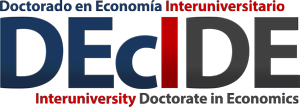Seminario 16/09: – Berta Ferrer (U. Lleida)- How and how much do air travellers spend? Bringing trip budget share and trip total expenditure together
Información
- Ponente: Berta Ferrer. Universidad de Lleida.
- Fecha: 12/May/2016 - 12:30 horas
- Lugar: Seminario del Departamento de Métodos Cuantitativos para la Economía y Empresa, UMU. Retransmisión en directo .

Microeconometric analysis of tourist expenditure as a function of traveler characteristics has focused on total absolute expenditure, on absolute expenditures per trip budget parts, and in relative terms per trip budget parts. The analysis of absolute trip expenditure by budget parts confounds how much (budget volume) and how (budget allocation) tourists spend, while that of trip budget share ignores budget volume. Analysis of absolute tourist expenditure per trip budget part (accommodation, transportation, etc.) often finds effects of the same sign on all budget parts. Such results are never obtained when analysing expenditure allocation (share or proportion devoted to each part). We propose to predict trip budget share and total budget volume within the same statistical model.
We draw from compositional data analysis (CODA). Share is transformed by means of log-ratios to capture allocation. A log-geometric mean of the absolute expenditures of interest captures volume. Share and volume can be tailored to the researchers’ own hypotheses and related to external variables by means of standard statistical models.
We use log-ratios of how tourists allocate budget between transportation and at-destination expenditures and of how they allocate at-destination expenses between accommodation&food and activities&shopping. We compute volume as the log-geometric mean of at-destination expenditures. We use official statistics microdata of European leisure visitors arriving to Spain by low cost airlines and organising the trip by themselves (n=14,446). MANOVA’s multivariate tests show which traveller characteristics are conjointly relevant and only gender is not. Univariate tests show education to affect only allocation and repeat visit only volume. Travel group, origin, income, age, and profession affect both.
Our approach avoids confounding how tourists distribute their expenditure and how much they spend. We show how log-ratios and totals can be tailored to the research questions. Once this has been done, analysis proceeds in the standard way.

